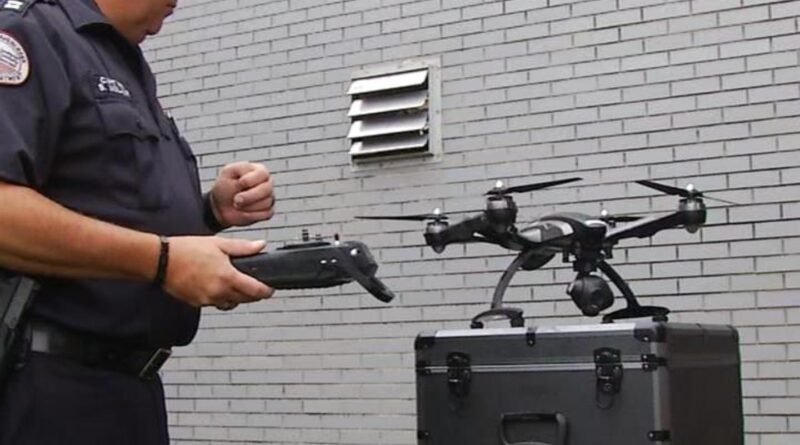Drones are serving as valuable tool for area law enforcement
Pictured is a drone used by local police departments. Photo courtesy of WKEF.
Samantha Neveril | Contributing Writer
News reports from cities around the world illustrate a rise in the utilization of unmanned aerial vehicles (UAVs) in law enforcement. These UAVs, more commonly known as drones, are seen as valuable tools by many police officers because they provide surveillance footage that aid in keeping communities safe.
The first drone operated by a civilian law enforcement agency was used in 2005 in Hays County, Texas. Since then, numerous police departments across the U.S. have implemented the technology, the city of Dayton being one of them.
In 2017, Fairborn and Beavercreek became the first cities in the greater Dayton area to acquire drones and train officers to operate them. Many other departments, including the Dayton Police Department, have followed suit.
According to police Sgt. Stephen V. Hargraves, the Dayton Police Department utilizes UAVs for real-time aerial surveillance. These devices are used in many different scenarios, including pre-tactical deployment reconnaissance, fugitive pursuit, search and rescue operations and as a de-escalation tool.
“UAVs are a valuable asset for any law enforcement agency,” Hargraves said in an emailed statement. “Their deployment enhances safety measures during patrol operations, serving as standoff tools to create distance between officers and potential threats, thereby mitigating risks and enabling effective communication with individuals in distress.
Drones help bring peace of mind to the officers, the suspects and the victims involved in incidents. The real-time updates that they provide are helpful in apprehending suspects.”
Hargraves also explained how these devices have been integrated into specialized units such as SWAT, hostage negotiation teams, bomb squads and crash reconstruction teams. He believes the implementation of drones in these sectors has enhanced the department’s law enforcement capabilities.
Hargraves said he frequently pilots a UAV for various law enforcement and public safety tasks.
“Our most significant recent mission involved canvassing the entire Mad River corridor from Eastwood Park southwest to downtown Dayton in search of a missing child,” Hargraves explained. “The search spanned over two and a half days and included 47 flight missions.”
Additionally, he noted that he has utilized drones to locate individuals who were ejected from severe car accidents and to find hidden suspects.
While the Dayton Police Department does not currently have a system in place that directly links UAV usage to the reduction of crime, it is noticeable that departments are relying on drones to help apprehend suspects.
For example, Hargraves explained how recently one of the Dayton Police Department’s UAV operators assisted another agency by locating a fugitive hiding in a wooded area. Ultimately, the UAV was able to guide the officers to the individual’s location.
Before an officer for the Dayton Police Department can become a UAV operator, they are required to go through training.
According to Hargraves, there are three levels of training to become a certified UAV pilot. The first level is an entry-level training that is made up of several hours of flight time and classroom work on Federal Aviation Administration requirements, constitutional law and safety. The next two levels focus on indoor and nighttime UAV operations.
Other departments in the area, such as the Montgomery County Sheriff’s Office, also utilize drones to navigate potentially dangerous situations.
The Montgomery County Sheriff’s Office acquired its first drone in 2019 to be used for first responders and crime scene investigations. The office’s deputies are trained and certified through a program at Sinclair Community College before they can operate the technology.
According to a Dayton Daily News article, leaders of the Montgomery County Sheriff’s Office and regional SWAT team said “robotics and drone technology add crucial tools for law enforcement to protect public and deputy safety, find endangered people and gather information during an emergency.”
The drones create a buffer between officers and potential danger.
“We have several drones that we use if we need to search buildings or large spaces without actually putting individuals in and putting them in danger,” Montgomery County Sheriff Rob Streck said.
Regardless of if the drones are being used by the Dayton Police Department or by the Montgomery County Sheriff’s Office, UAVs allow officers to navigate situations quickly and appropriately.
Specifically at the Dayton Police Department, Hargraves hopes to see the UAV program grow over time.
“My aim is to enhance our program by integrating thermal imaging technology, allowing us to detect individuals requiring emergency and police services, especially at night when darkness or fog makes it challenging to locate people” Hargraves stated.
Furthermore, recent advancements in UAV technology have led to smaller Safety UAVs being utilized within the department.
These drones are compact and lightweight. They are specifically designed for agility and maneuverability in indoor operations and close encounter situations. In the future, Hargraves hopes to enhance the deployment of the Safety UAVs to de-escalate situations.
As law enforcement agencies such as the Dayton Police Department and the Montgomery County Sheriff’s Office continue to integrate drones into their operations, their policing tactics will evolve. The use of UAVs signifies a shift in security and surveillance strategies, which will shape the future of community safety.
For more news around Dayton check out our news page here!

